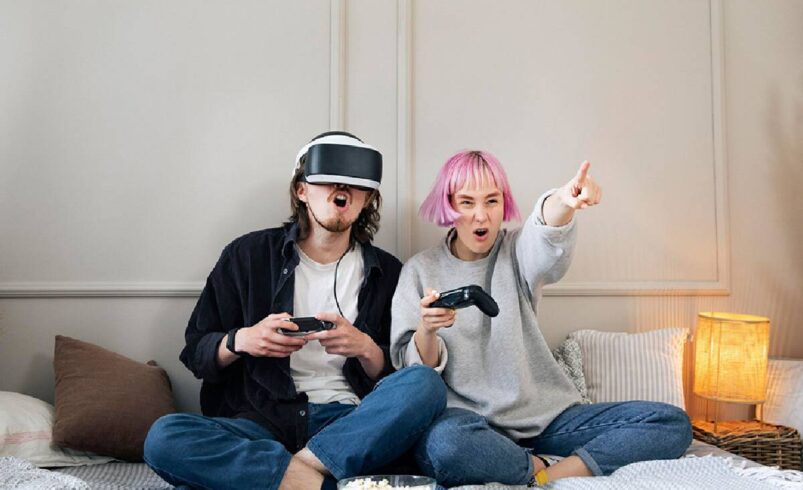Technology and leisure have changed a lot in recent years. Technology and play used to be separate. Now, they blend together, mixing work and fun. This change blurs the lines we once thought were clear. As we explore this changing landscape, we see how technology impacts our free time. This provides important insights into social changes, psychological needs, and leisure economics. This analysis looks at seven key aspects of this tech change. It shows how digital innovation opens new ways for people to relax. At the same time, it challenges old ideas about disconnecting and resting.
Immersive Virtual Worlds Redefining Recreational Boundaries
Virtual environments have gone beyond just gaming. They now offer new worlds for fun exploration. Last summer, I saw my nephew create an amazing building in a sandbox game. He used his imagination in ways that once needed real materials and special skills. These virtual spaces are now real places for fun activities, not just ways to escape reality. I’ve seen amazing changes in gaming. We’ve moved from simple early games to rich worlds. Now, people form friendships, create art, and even make a living. During the lockdowns, I hiked with friends online. We explored photorealistic mountains when we couldn’t hit the trails. The sensory experiences differed from hiking. However, the social connection and love for nature shone through clearly.
Traditional Games Finding New Life Through Digital Transformation
Classic pastimes that have entertained generations are experiencing remarkable revivals through technological reinvention. Board games that sit unused on shelves are now popular again. Digital versions remove setup time and save space. Our family’s weekend game nights changed when we found Ludo online. Now, we connect with relatives in three countries for weekly competitions. These digital changes keep the key elements and social fun of traditional games. They also make it easier for people to join in. Last month, I showed my grandfather how to play his favorite childhood card game using a tablet app. It was great to see his joy as the app found opponents who matched his skill level whenever he wanted to play. Accessibility goes beyond just convenience; it fosters inclusion. Automated rule enforcement helps newcomers learn games easily. This way, they avoid frustration that could drive them away.
Health-Integrated Recreation Creating Quantified Leisure
Tech integration has changed physical recreation. Now, tracking tools measure what used to be subjective experiences. Five years ago, I changed my casual neighborhood jogs into structured training sessions. I used wearable tech to track performance metrics. These used to be for elite athletes only. This quantification has led to new ways to motivate activities. These activities were always there but felt different. Gamification in physical activities is very effective for keeping people engaged. My hiking club saw a big jump in attendance. We used a shared challenge app that gave badges for reaching milestones together. These systems build stories around physical activities. This makes them feel less repetitive or pointless for some participants.
Customized Entertainment Ecosystems Replacing Mass Media Consumption
Technology has split our shared entertainment experience into personal choices. Streaming algorithms have really changed my leisure habits and entertainment choices. It’s a big difference from the broadcast TV I grew up with. This shift makes it easier to meet personal preferences. But, it also changes how we share media with others. The many choices have changed how we watch. Instead of just accepting what’s on, we now actively choose what to watch. My streaming watchlist is now so long that I couldn’t finish it in years. This makes choosing what to watch stressful. I didn’t feel this pressure when options were limited. Recommendation systems now act like entertainment buddies. They offer suggestions for what you might like. You don’t have to search through social channels. Content creation tools have made production easier. Now, the line between entertainment producers and consumers is less clear.
Leisure Skills Acquisition Transformed Through On-Demand Learning
Technology has changed how we learn leisure skills. Now, we have easy access to many instructional resources. Three summers ago, I learned guitar well. I used video lessons that matched my pace. This way, I didn’t need scheduled classes or a big budget. This accessibility has made it easier for everyone to develop recreational skills. Before, geographic and economic limits held many people back. Visual instructional content goes beyond what written guides can offer for physical skills. I can pause and rewatch woodworking techniques. This helps me copy expert hand positions easily. Traditional learning methods don’t allow for this. Learning privately before performing publicly has helped many people I know. This approach helps them beat fears that used to hold them back from what they love.
Social Connection Redefining Community-Based Leisure
Digital platforms have fundamentally reshaped how communities form around shared leisure interests. Ten years ago, my hobby of collecting mechanical puzzles felt lonely. I only found rare connections at special conventions. Today, I join weekly video chats with fans from around the world. This turns my solo interest into a fun, social experience that knows no borders.
Interest-based communities increasingly supplement or replace proximity-based social connections for leisure activities. Last winter, I joined an online cooking club. Members cook the same recipes at the same time while sharing videos. This creates a shared experience, even though we never meet in person. These virtual communities often move to in-person events. This creates hybrid social groups focused on shared hobbies instead of just location. Digital communication changes how we enjoy physical activities. We engage with them for longer periods.
Conclusion
Technology has changed leisure activities. It’s not just about digitizing old hobbies. Instead, it has redefined how we enjoy our free time. These changes open up amazing new chances for connection, creativity, and fun. But they also bring challenges for attention quality, experience depth, and social bonds. As technology grows, the best leisure strategies will focus on two key areas. First, knowing when digital tools can improve experiences. Second, know when to unplug and use traditional methods for our mental needs. Think of technology not just as good or bad for leisure. It’s more helpful to see the trade-offs involved. This awareness helps us make smarter choices about how we spend our free time.


